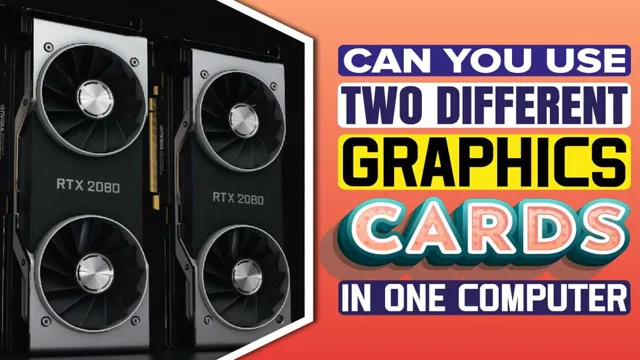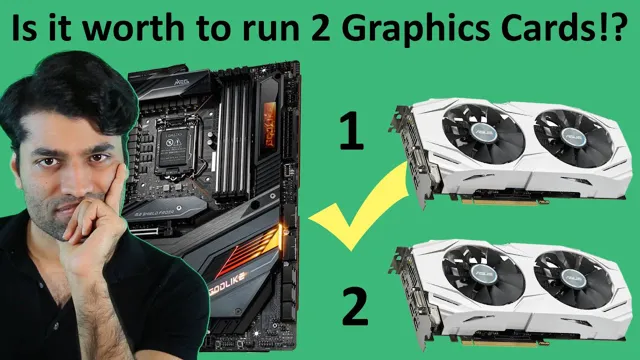If you’re a gamer or involved in designing, you understand that graphics cards play a significant role in displaying high-quality images. Although having just one graphics card is sufficient for most users, some people require higher graphical processing power, leading to the use of two graphics cards. Using two graphics cards can significantly enhance your computer’s performance and result in faster and smoother processing.
However, the process of using two graphics cards can be a little confusing for a beginner. In this guide, we will help you understand how to use two graphics cards effectively, the advantages of using two graphics cards, and some tips to keep in mind while using them. Whether you’re building a gaming rig or designing computer graphics, we’ve got you covered! Keep reading to learn more.
Compatibility Check
If you want to know how to use two graphics cards at once, first you need to check if your computer is compatible with CrossFire or SLI technology. These technologies allow you to combine the power of two graphics cards by linking them together. CrossFire is used by AMD Radeon cards, while SLI is used by Nvidia GeForce cards.
To use CrossFire or SLI, your motherboard must have appropriate slots for two graphics cards, and the graphics cards must be of the same model and series. However, keep in mind that not all games are compatible with CrossFire and SLI, so you should check if the games you play support these technologies. Additionally, using two graphics cards can increase power consumption and heat output, so make sure your power supply can handle it and your computer has proper cooling.
Ensure your motherboard supports multiple GPUs
If you’re looking to build a PC with multiple GPUs, it’s important to ensure that your motherboard is compatible. Not all motherboards support multiple GPUs, so it’s crucial to do your research before making a purchase. One way to confirm if your motherboard is compatible is to check its specifications.
Look for details on the number of PCIe slots available and the type of chipset that the motherboard uses. This will help you determine whether the motherboard is capable of supporting multiple GPUs. Additionally, it’s important to consider the power supply unit (PSU) of your system.
Multiple GPUs require more power, so you’ll need to confirm that your PSU is sufficient to power all the components in your build. Doing your compatibility check before purchasing any components will ensure that you can build a stable and functioning system with multiple GPUs.

Make sure your power supply can handle two cards
When it comes to running dual graphics cards in your PC, it’s crucial to ensure that your power supply is up to the task. Not all power supplies are created equal, and running multiple cards can put a significant strain on your system. Before you invest in a second GPU, it’s essential to check your power supply and ensure that it can handle the extra load.
Look up the power requirements for your graphics cards and add them together to get an estimate of the total wattage required. Then, check your power supply’s wattage rating and make sure it’s at least equal to that number. It’s also a good idea to ensure that your power supply has enough PCIe power connectors to connect both cards.
If your power supply falls short, consider upgrading to a higher wattage unit to avoid stability issues and potential hardware damage.
Preparing Your System
If you want to learn how to use two graphics cards at once, the first step is to prepare your system. This means ensuring that you have enough power to run both cards simultaneously. You may need to invest in a more powerful power supply if your existing one is not up to the task.
It is also essential to make sure that your motherboard can support multiple graphics cards. Check your motherboard manual to see if it has multiple PCIe slots or if it supports SLI or CrossFire, which are technologies that allow multiple graphics cards to work together. Finally, you need to have the right drivers installed for both graphics cards to ensure that they work together seamlessly.
Once you have prepared your system, you can move on to the next steps to set up your dual graphics card configuration.
Install the second graphics card in the appropriate slot
When it comes to installing a second graphics card in your system, the first step is to prepare your hardware accordingly. Before you even consider slotting in the card, make sure that your system is fully powered down and unplugged. Once you’ve opened up the case, locate the appropriate slot for your new graphics card.
This will likely be a PCIe slot, but be sure to consult your motherboard’s manual to ensure that you’re working with the correct one. Next, remove the protective slot cover on the back of the case, which will allow you to access the inside of the slot. Gently but firmly insert the graphics card into the slot, ensuring that the contacts on the card line up with those in the slot.
Once the card is in place, secure it with a screw or latch, depending on your case. Congratulations, you’ve successfully installed your second graphics card and are one step closer to an even more powerful gaming setup!
Ensure both graphics cards have the same driver software
When setting up a multi-GPU system, it’s crucial to ensure that both graphics cards have the same driver software. Mismatched drivers can cause a range of issues, including crashes, compatibility problems, and reduced performance. Before installing your additional GPU, make sure to check if it’s compatible with your existing hardware and that you have the appropriate drivers downloaded and updated.
Keeping your drivers up-to-date is especially important as new games and applications may require the latest software for optimal performance. By taking the time to ensure both of your graphics cards have the same driver software, you can avoid headaches down the line and ensure smooth operation of your multi-GPU system.
Connect both cards with a bridge
To connect both cards with a bridge, you need to prepare your system adequately. First, ensure that your system’s power supply can handle the additional hardware. Check the required power for both cards and see if your PSU can deliver it reliably.
If not, you may need to upgrade your power supply. Then, make sure your motherboard has the appropriate expansion slots for both cards. To bridge the cards, you’ll need a cross-over cable, which you can purchase from most hardware stores.
Once you have everything connected, you may need to install additional drivers or software to ensure the cards work correctly together. Don’t forget to adjust the settings in your operating system to optimize the connection between the two cards. With these steps, you can connect both cards with a bridge and take advantage of their combined power for improved performance.
Configuring the Cards
If you’re looking to boost your graphics performance, you might be wondering how to use two graphics cards at once. Fortunately, it’s possible to configure multiple GPUs to work together, and the process is simpler than you might think. Firstly, confirm that your motherboard supports SLI or CrossFireX technology, which allows the cards to communicate and work together.
Next, install the necessary drivers for both GPUs. Finally, configure your graphics settings to enable SLI or CrossFireX, and you’re ready to go! Keep in mind that not all applications will support multiple GPUs, so it’s important to research compatibility before making the investment. By implementing multiple graphics cards, you can achieve faster frame rates, improved graphics quality, and a better overall gaming experience.
Access the graphics card control panel
Accessing the graphics card control panel can be an essential step in configuring the cards to optimize gaming or other graphics-intensive applications. To do this, you can simply right-click on your desktop and select “Graphics Properties” or “NVIDIA Control Panel” if you are using an NVIDIA graphics card. From here, you can access various settings related to video quality, display, and performance.
You can adjust image sharpness, anti-aliasing, and other advanced settings to improve the visual quality of your gaming experience. You can also set up multiple displays and adjust screen resolutions to fit your preferences. Overall, accessing the graphics card control panel gives you a lot of power to customize and optimize your graphics card to get the most out of your gaming and other graphics-intensive applications.
Enable SLI or CrossFire technology
If you’re looking to get the most out of your gaming experience, enabling SLI or CrossFire technology can be a great option. These technologies allow you to use multiple graphics cards in your computer to deliver improved performance and smoother gameplay. However, to configure the cards properly, there are a few things you need to keep in mind.
Firstly, you need to make sure that both cards are compatible and that they have the same specifications. Next, you need to ensure that your power supply is adequate to deliver enough power to both cards. Once you’ve taken care of these basics, it’s time to enable the technology in your computer’s BIOS settings and install the necessary drivers.
With these steps taken care of, you should be able to enjoy high-quality, high-performance gaming that will take your experience to the next level.
Adjust graphics settings for optimal performance
If you want to get the most out of your graphics card, then it’s essential to adjust its settings for optimal performance. By configuring the card, you can ensure that it operates at its best and delivers the best possible experience for your computer games and other applications. One of the key things to consider when configuring your graphics card is the quality settings that you use.
Lower quality settings can help to improve performance, but they may also result in lower image quality and less detail. Higher quality settings can provide top-notch graphics but may cause your computer to slow down or even crash. By finding the right balance between these two factors, you can optimize your graphics card to deliver a fantastic gaming experience without any lag.
Testing Your Setup
If you’re a gamer or someone who relies on high performance for graphic-intensive tasks, using two graphics cards at the same time can significantly improve your PC’s performance. However, setting up and testing your setup can be a bit of a challenge, especially if you’re not familiar with the technical aspects of computer hardware. The first step is to check if your motherboard supports multiple graphics cards.
You can find this information on your manufacturer’s website or in your motherboard’s manual. Once you’ve confirmed that your motherboard supports it, you’ll need to enable SLI or Crossfire, depending on the type of graphics card you’re using. After enabling SLI or Crossfire, you’ll need to make sure that your graphics cards are seated properly and that all the necessary power connectors are plugged in.
Finally, you can test your setup by running benchmark tests or playing graphic-intensive games. By using two graphics cards at once, you can enjoy a smoother and faster computing experience, without having to upgrade your entire system.
Run benchmarks to test performance
If you want to make sure that your setup is fully optimized and running at its maximum potential, it’s essential to run benchmarks to test performance. There are many different tools that you can use to benchmark your system, and each one will give you different insights into how well your hardware and software are working together. By running benchmarks and analyzing the results, you can identify any areas where your system might be underperforming, and then take steps to optimize those areas.
This can help to enhance your system’s overall efficiency and prevent any slowdowns or bottlenecks. So, whether you’re a gamer, video editor, or just someone who wants their computer to run as smoothly as possible, it’s definitely worth taking the time to run benchmarks and optimize your system’s performance.
Play games to test gameplay and visual quality
Are you looking to test the capabilities of your gaming setup? One of the best ways to do this is by playing games that test both the gameplay and visual quality of your system. Not only is this a fun way to assess your setup, but it also helps you identify any potential issues that may need to be addressed. When testing gameplay, focus on games that require high levels of precision and quick reflexes, such as first-person shooters or fighting games.
This will give you a good indication of how well your computer or console can handle fast-paced action. For visual quality, choose games that feature stunning graphics and realistic environments, such as open-world adventure games or racing simulators. By playing a variety of games that stress different aspects of your setup, you can get a comprehensive understanding of its capabilities and how to optimize it for the best gaming experience.
Conclusion
In conclusion, using two graphics cards at once, also known as SLI or Crossfire, can greatly enhance your gaming experience. However, it requires careful consideration of compatibility, power supply, and cooling. Think of it like a dynamic duo – Batman and Robin, Sherlock Holmes and Dr.
Watson – they both bring their unique strengths to the table and work together to achieve a common goal. With SLI or Crossfire, your graphics cards can work together, each performing at their best, to deliver stunning graphics and smooth gameplay. So, suit up and take your gaming to the next level!”
FAQs
What is SLI and Crossfire technology?
SLI (Scalable Link Interface) and Crossfire are technologies that allow multiple graphics cards to work together to provide better performance.
Can I use two different graphics cards for SLI or Crossfire?
It is generally recommended to use two of the same graphics cards for SLI or Crossfire to avoid compatibility issues. However, some newer technology may allow for mixing brands.
How do I enable SLI or Crossfire on my computer?
To enable SLI or Crossfire, you will need to ensure that your motherboard and graphics cards support the technology. Then, you can typically enable it in your graphics card software or in your computer’s BIOS.
Do I need a special power supply to use two graphics cards?
Yes, running two graphics cards simultaneously will require more power than a single card. You will need to ensure that your power supply has enough wattage and the necessary connectors to support the additional card.


